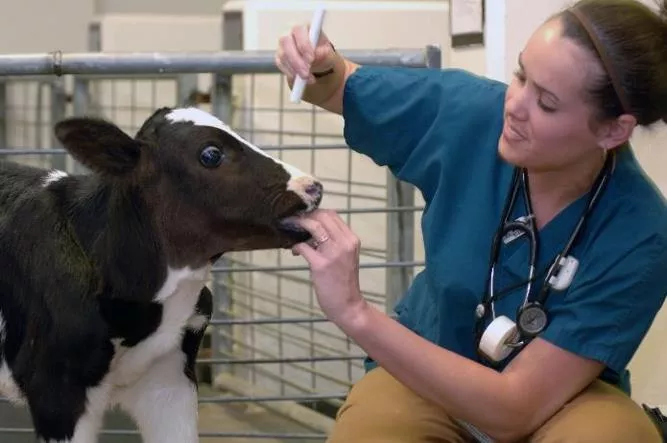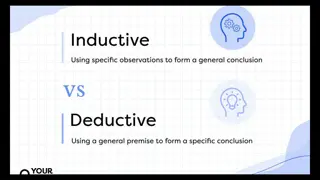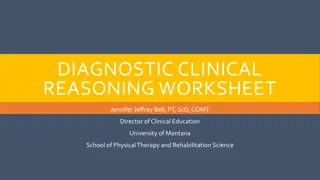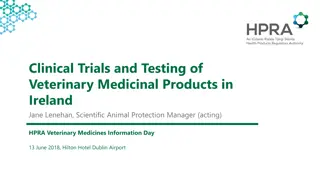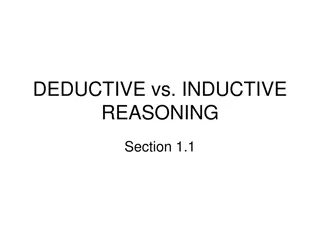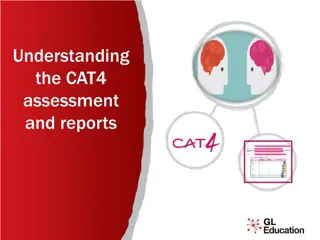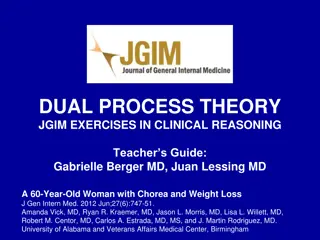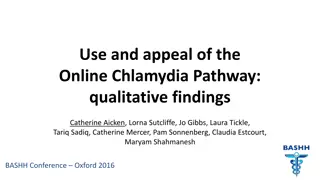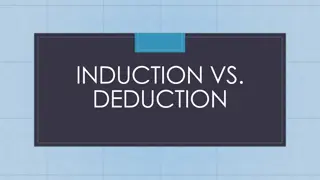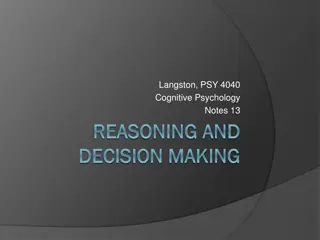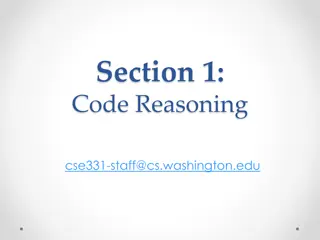Based on the provided content, here is the information you requested: Clinical Reasoning Pathway in Veterinary Education
Utilizing the Scripts Method, this approach integrates biomedical knowledge, clinical reasoning, and pattern recognition to enhance diagnostic skills and treatment decisions in veterinary students. Emphasizing active learning and continuous professional development, it aims to cultivate expertise in recognizing and managing animal health conditions effectively.
Download Presentation

Please find below an Image/Link to download the presentation.
The content on the website is provided AS IS for your information and personal use only. It may not be sold, licensed, or shared on other websites without obtaining consent from the author. Download presentation by click this link. If you encounter any issues during the download, it is possible that the publisher has removed the file from their server.
E N D
Presentation Transcript
Theory and Application of Scripts Method of Teaching SAREL VAN AMSTEL
Nutrition Theory Scripts Model in education Facilitates integration of new incoming information with existing knowledge Recognized system for developing the student s potential to become a successful clinical practitioner Efficient and effective Clinical reasoning Life long commitment I acceptas a lifelong obligation the continual improvement of my professional knowledge and competence . Anatomy Endocrinology Biomechanics Housing Lameness Periparturient diseases
Intuitive: Pattern recognition; Experience Analytical: Evidence ; Biomedical knowledge. Clinical reasoning Meaningful/associative learning. Related to previous knowledge within a framework Rote learning Knowledge organization Illness scripts Non-associative learning/Unretained/not linked Clinical expertise Biomedical knowledge Integration biomedical concepts associated with clinical information Biomedical knowledge Basic sciences followed by clinical training Disease presentation Disorganized clinical features Fail to recognize links Many hypothetical differentials Recognize links Short route to diagnosis
Illness script activation Most likely diagnosis Diagnosis Hypothesis generation Diagnosis Hypothesis testing Diagnostic verification Pattern recognition Pertinent background information Analytical Biomedical Science Observation Physical diagnostic techniques/skills Probabilistic evidence inferring conclusions Differentials/ maintaining coherent clinical view Intuitive New situations/patterns Case
Clinical reasoning/expertise pathway Clinical case Biomedical knowledge; Observation & physical diagnostic techniques; Experience Pertinent background information ILLNESS SCRIPT activation Pattern recognition and weighing evidence Differentials/ maintaining coherent clinical view Most likely diagnosis Diagnostic verification Definitive diagnosis Rational treatment/action
How to achieve clinical reasoning How to achieve clinical reasoning Within the veterinary curriculum Pre-clinical Clinical
Pre Pre- -clinical clinical Biomedical knowledge base should consist of content(the specific knowledge for any topic) and structure(the organization of the knowledge). teach the basic sciences in a clinical context introduce patient problems early in the curriculum CE & case discussions (small groups & class room) Electives & labs (Simulated models) VS Information overload lacking structure Teach less better!
Nottingham UK 1. Entire 4 year pre-clinical curriculum is delivered based on clinical context. 2. Teach in body systems but case based. 3. Use cases based on a survey of practitioners clinical work-load and represent common and important diseases by species. 4. Taught in modules. Clinical Science Module (CSM) (2nd year), Clinical Module (CM) (4th year) during the same 5 weeks of the year. 5. Enables vertical integration of the curriculum and peer learning 6. CSM illustrates clinical aspects of the biology that is given in labs and lectures eg, Stallion with retained testicle: Anatomy of testicle; Mechanism of testicular descent; Steroidgenesis; Results of the hCG-stimulation test. 7. CM same case concentrate more on Pathology/ Diagnosis/ Treatment / Management of the clinical problem.
Clinical Clinical Concept mapping Thinking aloud Case management Evaluation
Concept map construction Cross links new knowledge to previous knowledge within a preexisting cognitive network. Infectious claw disease 3 Main components Digital necrotizing cellulitis Foot rot ^ Indicates cross links Interdigital dermatitis * Indicates cross links Digital dermatitis Can cause Lameness*^ Infertility^ Antibiotic Topical spray pathological Lesion which Epidermitis* organism Footbaths*^ product CuSulfate*^ control Oxytetracycline control Spirochetes* Mode of Action Zn sulfate*^ Inhibit by Depress produce promotes < protein synthesis Manure contamination* Zn dependent MMP s* Aids formation Anti-inflammatory depress
Clinical teaching strategies based on script theory Concept mapping: Digital dermatitis Links/cross links Can cause x2 Productx2 Which Mode of actionx2 Path lesion Organism Controlx2 Produce Depressx2 Inhibits by x2 Aids Inhibits lameness Infertility AntibioticTopical spray Epidermitis Footbaths CuSulfate Oxytetracycline Spirochetes Zn sulfate < protein synthesis Manure contamination Zn dependent MMP s Anti-inflammatory
Clinical teaching strategies based on script theory Concept mapping: Digital dermatitis Can cause pathological Lesion which organismcontrol product control Mode of Action Inhibit by Depress produce Inhibits Aids depress
Concept mapping Cross links new knowledge to previous knowledge within a preexisting cognitive network. Infectious claw disease 3 Main concepts Digital necrotizing cellulitis Foot rot Interdigital dermatitis Digital dermatitis lameness Epidermitis CuSulfate Oxytetracycline Spirochetes Zn sulfate Manure contamination Zn dependent MMP s Anti-inflammatory
Laminitis. (Total confinement free stall dairies) Main pathways Enzymatic/ Hormonal Mechanical Caused by Caused by Nutritional Rumen acidosis Calving Walking surface Mechanism/pathways Types Periparturient disease Mechanism Hormones/MMP s Mechanism/pathway Smooth Rough Result in LPS/Cytokines/MMP s Thin sole Mechanism Sole Overgrowth Mechanism/pathway Mechanism Result in Abnormal weight bearing Sinking P3 Result in Result in Corium concussion Ulcers/white line
Congestive heart failure CHF List of concepts Diastolic dysfunction Ventricular inability to eject blood Coronary artery disease Cardiac stress testing Coronary angiography Ventricular inability to fill Can be classified by pathophysiology as May be defined as May be defined as Is commonly caused by Can be evaluated by
Concept mapping Concept mapping: Tool for knowledge organization and representation Continue to build and revise the same map Can be used for team based learning Promotes participation Builds confidence Can be used as an assessment tool
Think-aloud strategies: Role of the teacher is not to transmit knowledge but to facilitate learning, encourage spontaneity and engage in mutual enquiry John Dewey (American philosopher, psychologist, and educational reformer whose ideas have been influential in education and social reform.) Go on Otter expedition Team thinking . This is what I am thinking . What are you thinking Merge biomedical information with clinical concepts Challenge them to challenge your opinions and convictions
Clinical case overview Create sufficient time to review clinical cases seen same/previous day/s Case summary Retrospective analysis Dissect and expose errors making sure the basis/reason for these are clearly understood Make sure findings are explained and understood including all physiological linkages Absence of fever in case of pneumonia Significance of one finding in the presence of that finding. Discharging tract on dorsal wall at coronary band
Case management Students should be assigned to manage/encouraged to take control of their cases Oversee observational and physical exam skills (What can you see/feel/hear?) Do not provide diagnostic/ treatment plan. Must be justified.
Evaluation Provide or refer to relevant sources of information and encourage to read consistent with the script approach. Test-enhanced learning: Knowledge-integrated tests and clinical reasoning problems Puzzlers
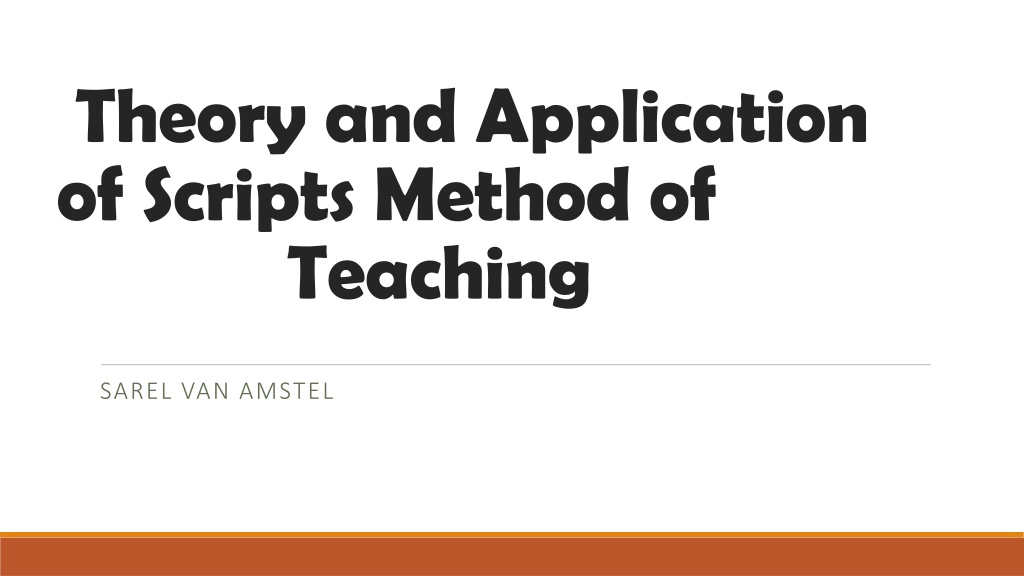
 undefined
undefined















